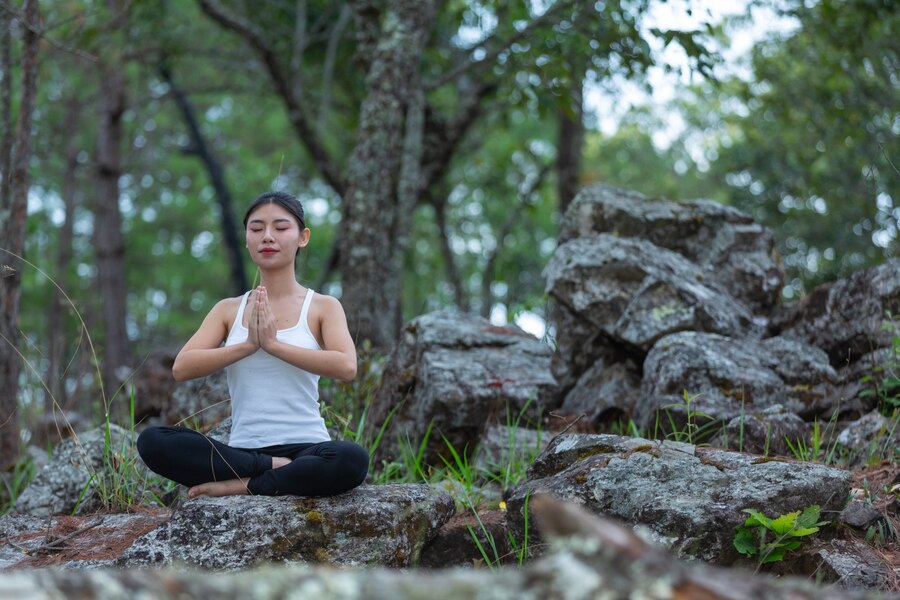Whatever exists in this world, is all under the control of Prana. Prana protects us as a mother protects her children, and gives us affluence and intelligence.
Pranayama’s ancient wisdom is experiencing a modern renaissance. While the practice has existed for millennia, its profound benefits resonate with a global audience. This surge in interest has provoked many curious minds to ask, “What is pranayama yoga?” or “What is pranayama?”
Pranayama is an age-old yogic discipline originating from India that revolves around breathing techniques designed to enhance physical, mental, and spiritual well-being. Sage Patanjali has described this in the fourth limb of the Ashtanga Yoga as pranayama benefits the quality of life by acing the breath.
With this blog, get ready to experience the transformative powers of this ancient discipline by understanding the technique, its basics, types, benefits and methodologies. If you are a beginner, you might need assistance for your initial days of pranayama. To help you achieve your goal we have curated videos and have developed support from teachers to guide you through. So make the most of it.
What is Pranayama: Types, Benefits & Traditional Techniques
Two Sanskrit terms, “Prana” (meaning ‘life force’ or ‘vital energy’) and “Ayama” (meaning ‘control’ or ‘extension’), are combined to form the word Pranayama. It simply means ‘control of the ultimate life force’. In regards to this, do you know what is the base element of pranayama? It is all about breathing and adapting to various ways to regulate it. Thus, pranayama is a method of channelling and directing the life force in the body, influencing psychological moods. It is not limited to just gaining control over breath. It goes beyond that. Practising pranayama benefits your health and consciousness by optimising the flow of energy through the body.
Types and Benefits of Pranayama
Now that you have got a glimpse of what is pranayama yoga, it is important to know that Pranayama practices involve a variety of techniques. Each of these has its unique method, profoundly influencing both the mind and body.
Let’s learn more about these and get your question, what are the benefits of Pranayama?
| No. | Types of Pranayamas | How to do Pranayama | Benefits |
| 1. | Bhastrika Pranayama (Bellows Breath) | This requires active breathing much like how bellows work. The abdominal muscles push the air out of the lungs forcefully and help in inhaling deeply. | It is known as a good way to keep your mind away from negativity and boost energy. This method increases oxygen flow to the brain. It also improves vitality and cognitive functions altogether. |
| 2. | Kapalbhati Pranayama (Skull Shining Breath) | Characterised by a series of forceful exhalations followed by passive inhalations, engaging the diaphragm and abdominal muscles to expel the breath. | This technique has detoxifying effects and boosts metabolic rate. Additionally, it calms the frontal sinuses, improves brain oxygenation, and stimulates the abdominal organs. |
| 3. | Nadi Shodhan Pranayama (Alternate Nostril Breathing) | Involves inhaling through one nostril, closing it off with the thumb, and exhaling through the other nostril using the ring finger to control the flow. | It balances both the hemispheres of the brain.Calms the mind.Enhances neurological and cardiovascular function.Reduces stress. |
| 4. | Bhramari Pranayama (Bee Breath) | Closing the ears with the thumbs, and fingers over the eyes, inhale deeply and make a high-pitched humming sound like a bee while exhaling. | Great for calming the mind almost instantly.Reducing stress and anxiety. It can also alleviate migraines and improve concentration. |
| 5. | Ujjayi Pranayama (Ocean Breath) | While performing this pranayama, you are required to make a calming ocean-like sound. To begin, inhale and exhale through your nose while keeping your throat a little tight | It enhances lung capacity and builds energy.It regulates blood pressure and helps in the management of thyroid issues. |
| 6. | Sitali Pranayama (Cooling Breath) | For this, your tongue should be longitudinally curled and slightly past your lips. Breathe in with your mouth, and release the air through your nose. | It helps to cool down the body by adding moisture to the systemIt soothes a pitta imbalance such as inflammation and heat in the body. |
| 7. | Anulom Vilom Pranayama (Alternate Nostril Breathing) | Sit in a comfortable meditative posture. Close the right nostril with your right thumb, inhale slowly through the left nostril, and then close it with your fingers. Open the right nostril and exhale slowly. Repeat the process. | It helps balance both the hemispheres of the brain. It calms the mind by promoting mental clarity.It improves respiratory functions. |
| 8. | Sheetkari Pranayama (Hissing Breath) | Sit in a comfortable position with your teeth clenched together and exposed. Part your lips while in the process. Inhale through the mouth and exhale slowly through the nose. | It cools down the body and brings calmness to the mind.Can help manage stress and anxiety. This pranayama benefits those who suffer from hypertension. |

Traditional Pranayama Techniques You Should Know
Pranayama is not only about breathing right, it is an art that harnesses the life force. To achieve a balanced state one must follow disciplined breathing techniques. Basically, these techniques and practices involve three fundamental stages where each stage plays a crucial role in enhancing vitality and mental clarity. Here’s how you can understand and incorporate these traditional techniques into your regular pranayama practice:
Puraka (Inhalation)
Puraka involves a mindful inhalation into the lungs, focusing on a deep and controlled intake of air through the nostrils. This deliberate action allows the chest and abdomen to expand as they fill with air, not just for oxygenation but also for energising the body. It sets the stage for energy retention, preparing the prana, or life force, to circulate effectively throughout the body. This step in pranayama benefits all the vital parts of the body thus making you feel energetic by regulating the physiological processes.
Kumbhaka (Breath Retention)
Kumbhaka is the practice of holding the breath after a full inhalation, marking a pause between inhalation and exhalation. This pause should feel comfortable and strain-free without stretching the practitioner’s capability. You can gradually extend the duration as you become more adaptive. The retention of breath is crucial for the assimilation of prana across the body, enhancing oxygen absorption and fostering internal rejuvenation.
Rechaka (Exhalation)
Rechaka is a deliberate and controlled process of exhalation of air where you are required to exhale gradually through the nose. During this, the abdomen contracts towards the diaphragm enabling a deep cleansing of unfavourable feelings. Thus, this last round encourages calmness, and brings mental clarity, ultimately reducing stress.
In exploring “how many types of Pranayama” exist, one can grasp the breadth and depth of this practice in enhancing well-being. Discover the transformative power of your breath by starting with the basics and gradually advancing to more complex practices.
For the ultimate guidance and experience, watch our videos or reach out to our Soul Senseis.
Sources
- Jayawardena, R., Ranasinghe, P., Ranawaka, H., Gamage, N., Dissanayake, D. and Misra, A. (2020). Exploring the therapeutic benefits of ‘Pranayama’ (yogic breathing): A systematic review. International Journal of Yoga, [online] 13(2), p.99.








